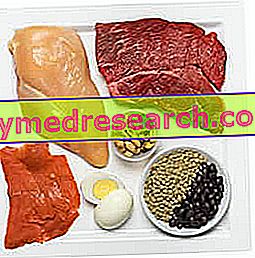Proteins: Quality and Quantity
There are many food protein sources; the foods that contain the most are: eggs, milk + dairy derivatives and all types of meat (including fishery products); subsequently we find legumes and cereals; finally, low amounts of protein are present in vegetables and fruit.

Recommended contribution
How many proteins in the diet?
Dietary proteins represent a portion of macronutrients which is, to say the least, fundamental for maintaining health status. Their "quantity" is still the subject of numerous discussions but the most important scientific institutions affirm that the supply of protein with the diet should remain at 12-13% of the total kcal; to define the quantity with greater precision it is also possible to use a coefficient of g / kg to be multiplied by the subject's desirable physiological weight (from 0.75 to 1.5). Obviously the aforementioned coefficient changes according to age, therefore based on the development phase; it can rarely undergo significant percentage changes based on the level of sporting activity.
In the eyes of many people, whether they are profane or professional, the "recommended" protein intake is scarce or at least insufficient. In reality, taking for granted a balanced, normocaloric diet characterized by high biological value proteins, the amino acids introduced should have the task of replacing the oxidized or deteriorated ones already present in the body; having said that, it is natural to think that the greater the metabolic commitment (sport, growth, pyrexia, other pathologies ...) and the greater the contribution of protein with the diet should be. In reality, the variables to be considered are decidedly more numerous and this statement can only be partially confirmed. Notwithstanding that, as far as we can generalize by discussing dietetic application, there are always big intra and interindividual differences, in my opinion it would be appropriate to specify an absolutely essential detail: although it is correct to think that all tissues contain proteins and that they need a continuous turn-over of amino acids, it is true that the remodeling of the structures does NOT necessarily provide for the elimination of broken proteins!
The structurally intact amino acids, as if they were "lego bricks", are reused for the synthesis of the essential proteins. Ultimately, there are certainly situations for which it is necessary to modify the protein intake but not as much as you can guess; rather, in my opinion, the distribution of proteins in daily meals and the quality of the same assessed by the estimation of the Biological Value is of greater importance.



